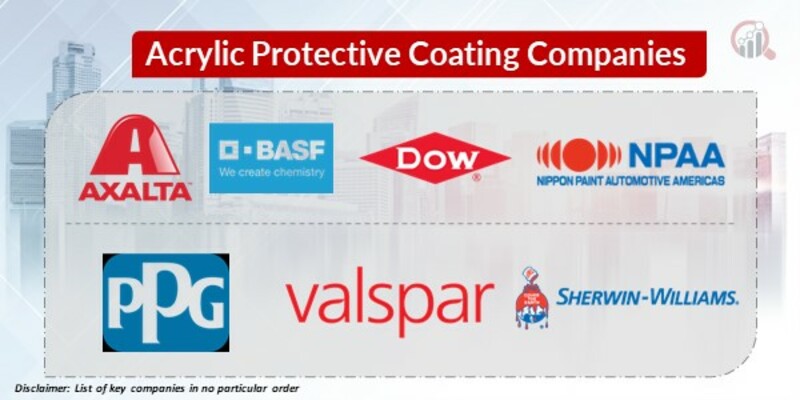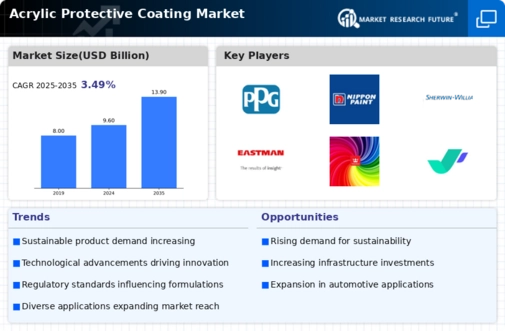Top Industry Leaders in the Acrylic Protective Coating Market

The acrylic protective coating market is a dynamic arena buzzing with established giants and agile newcomers. Understanding the competitive landscape of this market requires a deep dive into strategies, market share determinants, industry news, and recent developments.
Strategies Adopted by Market Leaders:
- Product Innovation: Leading players like PPG Industries, Arkema, and Sika are pouring resources into developing cutting-edge acrylic coatings with enhanced durability, weather resistance, and sustainability. This includes self-healing coatings, UV-protective formulations, and bio-based resins.
- Market Diversification: Established companies are expanding their reach beyond traditional applications like architecture and construction, venturing into automotive, marine, and industrial sectors. This diversification mitigates risk and opens new revenue streams.
- Strategic Partnerships and Acquisitions: Mergers and acquisitions are a key growth driver, allowing companies to consolidate their market position, acquire new technologies, and expand their geographical footprint. Recent examples include PPG's acquisition of Tikkurila and AkzoNobel's purchase of New Nautica Coatings.
- Sustainability Focus: Environmental consciousness is driving the development of eco-friendly acrylic coatings with low VOC emissions and bio-based ingredients. Companies like Valspar and Axalta Coating Systems are actively promoting sustainable solutions to differentiate themselves.
- Digitalization and Customer Service: Embracing digital technologies like AI-powered product recommendations and online sales platforms is crucial for customer engagement and market penetration. Additionally, providing exceptional technical support and value-added services is key to building brand loyalty.
Factors Influencing Market Share:
- Product Quality and Performance: Superior performance in terms of durability, adhesion, and weather resistance are crucial for market dominance. Companies constantly strive to improve their formulations and offer differentiated products.
- Brand Reputation and Customer Trust: Established brands like Jotun and Kansai Paint have a strong reputation for quality and reliability, giving them a significant edge over smaller players. Building trust through consistent quality and customer service is essential for long-term success.
- Regional Demand and Growth Potential: Emerging economies like China and India are witnessing a surge in construction and infrastructure projects, driving demand for acrylic protective coatings. Companies actively cater to these markets with localized offerings and strategic partnerships.
- Regulations and Environmental Standards: Stringent environmental regulations, particularly in Europe, are pushing the development of low-VOC and eco-friendly coatings. Companies that comply with these regulations gain a competitive advantage.
- Pricing and Distribution Strategies: Competitive pricing strategies and efficient distribution networks are critical for market penetration and profitability. Companies are exploring diverse distribution channels, including online platforms and direct-to-consumer sales.
List of Key Players in the Acrylic Protective Coating Market
- Axalta Coating Systems,
- BASF,
- The Dow Chemical Company,
- Nippon Paint,
- PPG Industries,
- Valspar Corporation, and
- Sherwin-Williams.
Recent Developments:
September 2023: Sika AG acquires a leading manufacturer of UV-curable acrylic coatings, strengthening its position in the specialty coatings market.
October 2023: Axalta Coating Systems partners with a startup developing self-healing acrylic coatings for automotive applications, demonstrating a commitment to disruptive technologies.
November 2023: RPM International reports strong demand for its acrylic-based industrial coatings, reflecting the resilience of the sector despite economic headwinds.
December 2023: The Chinese government announces new regulations on VOC emissions from coatings, prompting manufacturers to invest in eco-friendly acrylic technologies









